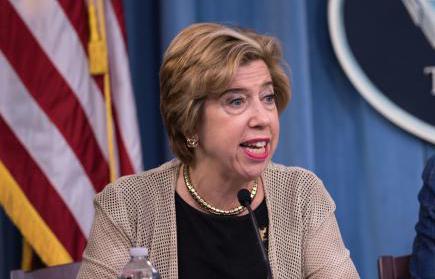DOD Targets Acquisition Reform
The Defense Department is pursuing acquisition improvements to improve the effectiveness of its solicitation processes, to advance the cybersecurity of needed solutions and to meet rising adversarial threats, according to Undersecretary of Defense for Acquisition and Sustainment Ellen Lord.
“We have made significant progress in the field of acquisition reform in 2018,” Lord said. “And in 2019 we will continue efforts to improve the way the department does business.”
Last year, the DOD began the largest reorganization in 30 years within the Office of the Secretary of Defense (OSD) with the Congressionally mandated split of the acquisition, technology and logistics (ATL) office into two organizations, Acquisition and Sustainment (A&S), which Lord is leading, and Research and Engineering (R&E), which is headed up by the Undersecretary of Defense for Research and Engineering Michael Griffin.
“A&S has been shaped into an organization that provides a defense-wide adaptive acquisition framework that spans from the demand signal to disposal, with data-driven analysis linked to the National Defense Strategy objectives,” Lord explained. “It scales to enable innovation and supports a culture of innovation, critical thinking and creative compliance. And I am committed to creating a culture of creative compliance, scaling innovation from pockets of excellence and mainstreaming authorities provided by Congress.”
The acquisition reforms are targeting Section 804 middle tier acquisitions, used for obtaining capabilities within two to five years, as outlined by the National Defense Authorization Act (NDAA) of 2016. A&S is working on drafting a formal policy that builds upon the interim Section 804 policy released in April of 2018, Lord noted.
The office improved other transaction authority (OTA) contract availability by increasing dollar thresholds and expanding OTA use to organizations in DOD with contracting authority. It also published an OTA handbook, which the National Defense University turned into a series of training workshops. “This was important because it improved policy and guidance while clarifying definitions and providing guidance on problem areas,” Lord said.
Another major initiative, Lord said, was the rewriting of DOD acquisition policy I-5000.2, which “provides policies and principles that govern the defense acquisition system and forms the foundation for all DOD programs.” Among other measures that “implement direction to streamline discussion of the defense acquisition process,” the policy will not improve the 5000.2 contracting requirements, she said. “Instead of making people identify and justify removal of current 5000.2 requirements, we will start with a clean sheet and build up using the simplest way to be creatively compliant.”
The reforms also insert cybersecurity requirements into the contracting process, a much-needed change that includes accountability from suppliers, the undersecretary stressed. “Our understanding of cyber vulnerabilities has greatly increased in recent years,” Lord stated. “We need to make sure we have a clear definition of how weapons systems need to be cyber hardened and how we will assess compliance.”
DOD will incorporate cybersecurity standard language into contracts, especially for the defense industrial base, “because we have seen vulnerabilities in the data systems and software development environments of our contractors,” she noted. “We need to help them with crisp ISO 9000-like cybersecurity standards set, so that they know the requirements we will hold them to, requirements with metrics that are auditable by third parties.”
As for intellectual property (IP) rights, the DOD will improve its management and protection of IP by using standard language clauses in contracts both for sustainment and for development. “The right IP posture allows us to make smart decisions through the life cycle of our systems to manage costs,” Lord suggested.
In a step to decrease the number contract award protests by the industry, the DOD is improving its request for proposal (RFP) documents. “Vague language in RFPs and unclear descriptions of the intended source selection process contributes to protests,” Lord admitted. “We understand that if we are more precise in our RFPs, we can reduce the time we spend resolving protests.”
Moreover, software-related solicitations will go after agile software methods known as DevSecOps. “Our systems need to be hardware-enabled and software-defined,” she said. “We need to create a secure environment that supports DevSecOps for big defense contractors and small innovative companies.”
To stop adversaries investing in and benefiting from U.S. military solutions, A&S is implementing a new departmental program called the Trusted Capital Marketplace, or TCM. It is a public-private partnership that will organize “trusted sources of private capital with innovative companies that are critical to the United States’ defense industrial base and national security,” the undersecretary clarified. The TCM builds upon a pilot program created by the NDAA 2018 that aimed at bringing in more small- and medium-sized companies to create innovative technologies.
“China is increasingly attempting to erase research and development gains by leveraging and manipulating economic tools like investment in U.S. companies with technology critical to our national security,” Lord warned.
Finally, Lord emphasized the DOD’s pursuit of acquisition reforms had to be in conjunction with the industry.
“The department cannot achieve the full breadth of these reforms and modernization priorities alone,” she said. “We must continue to partner with the private sector and Congress. I meet routinely with our industry's partners. We meet one-on-one with CEOs monthly, jointly with major defense contractor leadership teams and senior DOD and service representatives, and more broadly with the industry trade associations, [to] talk about challenges and opportunities and how we can best work together.”





Comment
I suspect that the real
I suspect that the real problem is that the DOD acquisition process has been "reformed" to the point where it has become completely dysfunctional.
Comments